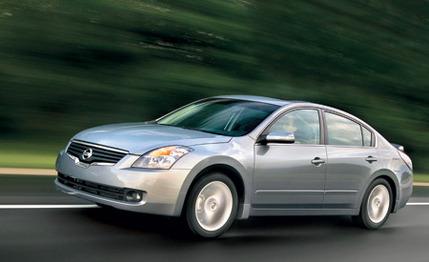
 Road Test
Road Test
Could downsizing be the fashion once again? It is at Nissan. This new Altima is fresh off the chopping block.
With high gas prices, it's logical to think that automakers are reaching for a quick mpg improver. But fuel was still cheap when the new-in-2002 model returned to the incubator for its next-cycle redesign. And Nissan had a different goal: Ramp up the sporty feeling that separates the Altima from its more reserved Camry and Accord competitors. Nissan wanted quicker responses, more agility, and easier maneuvering in the metro madness.
So the wheelbase was abbreviated almost an inch, and nearly three times that much came off overall length. Width is up a fraction, height stays the same.
And sportiness? If you choose the SE version with the 270-hp V-6 and six-speed manual, hang on. Engine output is up 20 horsepower in the advertising but more in the car, thanks to the deflationary effect of the latest SAE rating system. Weight, at 3357 pounds, is 137 more than the Altima we tested in February 2003. Thinner sections of higher-strength steel bring a stiffer structure - you can feel the difference - with a small weight increase.
The stronger engine easily makes up for the extra pounds. Getting from 0 to 60 at 5.9 seconds ties the 2003 car; the new one runs away in the quarter-mile, finishing at 99 mph (96 in the older car). Elapsed time for both cars is the same, 14.6 seconds. Fuel economy is up 1 mpg on the highway compared with the old base model, to 21 city and 29 highway, creditable for a mobile with this much zing.
The big news is not the numbers, however. The V-6 Altima has always been powerful, and it's always been nasty for torque steer in the lower gears. Enough already, Nissan decided. The fix: Lower the powerplant 0.6 inch to level the half-shafts and equalize the joint angles side to side. Steering geometry is also significantly revised.
The 3.5 has torque enough to easily buzz the tires on launch. But there's little tugging on the wheel now and little deviation in the path when the power goes down. Unruly no more, this front-driver.
V-6 Altimas come in SL and SE versions. SE, the sporty choice, has a stiffer suspension calibration with crisp-riding shocks. Its wheels are up one inch in diameter and wider by a half-inch to 7.5. It gets lower-profile 215/55R-17 all-season tires and faster-ratio power steering. Steering effort now rises with speed, a first for the Altima. Over the road the ride is reassuringly quiet, a pay-off for the newly stiffened structure, but the shocks don't hide the bumps. Compared with the SL version, the SE's moves are muscular. The seat is on the hard side with very good lateral support in the backrest. The left-foot dead pedal is perfect.
We measured 0.81 g on the skidpad, with determined understeer at the limit. The independent rear suspension was redesigned for less jacking and better control of roll-rate changes. As cornering forces rise, the car is less twitchy now.
Four-wheel discs are standard, stopping from 70 mph in 180 feet. Nissan changed its brake-pedal linkage to what it calls a double-pivot design, this to keep the brake response similar in both hard and easy stops. It works. Pedal response is agreeably linear, never touchy.
Too bad the same cleverness hasn't been applied to the clutch and shifter. The clutch has an unsatisfying effort curve as the pedal comes up, making it harder than it should be to anticipate engagement, and the shifter clunks through its prominent detents. The Altima is no BMW in this regard; no Honda, either.
The outgoing Altima was a huge success for Nissan, lifting sales from 137,000 of the older, smaller-bodied version in 2000 to 255,000 last year, making it the fourth-highest-selling car in the U.S. Hoping to continue this impressive conquest into Camry-Accord territory, Nissan has endowed this new model with a strong features list, starting with standard-equipment keyless entry and pushbutton starting. No huzzahs from us on this item - with the ignition keyhole gone, the bulky fob now takes up a cup holder. From an ergonomic standpoint, the fob shape is too susceptible to getting its buttons inadvertently pushed in routine handling. Who popped the trunk?